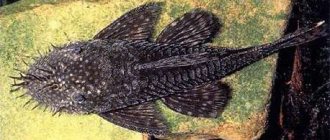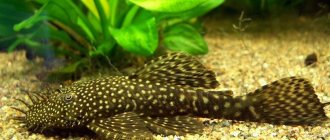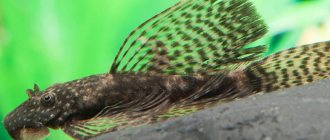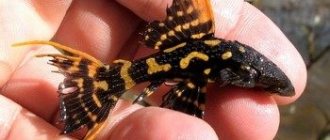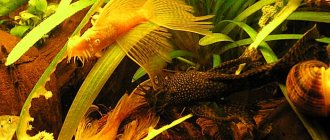The home aquarium is a timeless classic of the “living” interior. Bright and active fish not only decorate your home, but also give peace. This is especially true for the “informals” of the underwater world, capable of refreshing any corner of the water, for example, the sticky catfish, whose habits will not leave anyone indifferent.
Ancistrus is an aquarium catfish with original habits and a peaceful character.
Description and characteristics
The catfish belongs to the chain-mail fish family, and lives mainly in mountain rivers and tributaries. The phenotype has funny behavior and an unusual appearance, but this is not the main feature of the fish. Catfish in the aquarium feed on the smallest algae and plaque on the walls of the tank, playing the role of a cleaner and assisting the aquarist. Distinctive external signs of stuck fish:
- elongated, oblong body;
- rounded sucker mouth;
- flattened head;
- large flag-shaped dorsal fin;
- the fins on the chest and abdomen are wide.
The color of ancistrus can be of different colors, and varies from gray to black shades, sometimes there are blotches of light or dark tones on the body. The lifespan of catfish is eight years, provided that the pet is provided with good living conditions and proper feeding.
Aquarium species of Ancistrus catfish:
- Golden albino is a popular and desired variety by many aquarists, characterized by a pale body color with a golden sheen.
- Red ancistrus - this type of catfish was bred artificially, resulting in an ancistrus with a yellow-red or bright orange body color.
- Catfish Claro - stands out from other species due to its body color: color can vary from gray to charcoal with light splashes.
- Star ancistrus - a species that migrated to aquariums from tributaries of the Amazon River. The color of the star sticker ranges from coffee to black, and there are also light tiny spots on the body.
Breeding catfish
Breeding catfish is not difficult
Breeding catfish at home is easy. If you only have catfish in your aquarium, then you don’t even have to place them separately in another container. If you still place catfish with other fish, then for breeding it is better to put them in a container with clean water, 30-50 liters in capacity. As a rule, 3-4 males need to be placed per 1 female. It is better to put soft soil at the bottom of the aquarium and take care of the abundance of algae.
To encourage catfish to mate, experts recommend changing the water for several days, replacing it with a fresh portion, at a temperature of 17-5 degrees, and aerating.
Fish usually spawn early in the morning. After the eggs are laid, you can darken the aquarium or simply leave it in natural light. A week after spawning, the female will be ready for a new spawning.
The young catfish grow quickly, and almost immediately they can be fed with finely chopped bloodworms.
Keeping in an aquarium
Keeping ancistrus catfish is simple, since the phenotype is unpretentious and peaceful. A couple of fish should be kept in a tank with a volume of 80-100 liters, since the stuck catfish is active and mobile. It should be noted that two females, or a female and a male, can be placed in one aquarium, but two males cannot be kept together, otherwise they will fight.
Keeping catfish in an aquarium environment implies the following water parameters:
- hardness – 2-18 dH;
- water temperature – 17-30C.
The fluid in the artificial reservoir is renewed weekly, replacing 1/4 of the volume. Despite the fact that fish stuck is an excellent cleaner of the aquatic environment, for a long life the pet needs clean water, so a filter and an aerator are installed in the aquarium. You can determine the purity and amount of oxygen in the water by the behavior of catfish: if ancistrus often swim to the surface, then something is wrong with the liquid.
The vegetation in an aquarium with ancistrus is planted alive, with hard and durable leaves, otherwise funny catfish will certainly gnaw on the lush and soft foliage. The underwater flora is placed in a dense layer, leaving a small area for swimming and feeding. Pebbles are usually used as soil, which can be of medium or large fraction. Lighting is set to moderate.
Catfish are bottom dwellers, and the fish spend most of their time at the bottom. The phenotype is peaceful and somewhat timid, so it often hides in secluded places and algae. For peace of mind for pets, aquarists place houses, shelters, caves and grottoes in the tank. It is also necessary to place driftwood in the aquarium, which will decorate the pond and serve as additional food for the catfish, since this fish sometimes feeds on wood. With good care and caring attitude, sticky catfish live from 6 to 10 years.
Sacbranch catfish
The sacbranch catfish can become a very unusual decoration for an aquarium. This variety of aquarium catfish has an elongated, flexible body; its build and habits resemble a well-fed snake. On its head there are thin long antennae, with the help of which the catfish searches for food.
These fish have a unique structure: air sacs are located along the lower part of the body, thanks to which the fish can breathe atmospheric air, swallowing it from the surface. It is better to ensure that the aquarium lid is always closed. This allows you to maintain a constant temperature of the breathing air and prevents the catfish from jumping out of the aquarium.
Another feature of this type of catfish is the poisonous endings of the dorsal and pectoral fins. When caring for an aquarium where the sacbranch catfish lives, you need to be careful; the sting of the poisonous fins is quite painful.
These fish can be quite active during the daytime, rising to the surface for air or picking up leftover food on the bottom.
It must be taken into account that the sacbranch catfish is a predatory fish, so keeping an aquarium catfish is only possible with sufficiently large, mobile fish. It may mistake small fish for a type of food, and territorial disputes are possible with other large bottom inhabitants.
Nutrition
One of the most pressing problems in keeping ancistrus is the question of what to feed the catfish. Despite the fact that fish are able to feed on the smallest algae and plaque, pets must be fed with the following types of food:
- vegetable food tablets;
- frozen food: coretra, bloodworms;
- vegetables processed with boiling water: zucchini, pumpkin, peas, pumpkin;
- live food: tubifex, daphnia, worms, insect larvae.
When compiling a diet, it should be taken into account that plant foods should make up 80% of the volume, and protein – 20%. Not only the health of fish, but also the reproduction of catfish depends on proper nutrition.
Feeding
In their natural environment, ancistrus feed on algae, the remains of protein food on the bottom, and, less often, plant food. It is because of their ability to clean the aquarium of algae that aquarists most often keep catfish, believing that this allows them to monitor the aquarium less. Catfish need extra food. When moving into a new aquarium, ancistrus feed only on algae, but they quickly clear the aquarium and begin to starve without additional food.
Catfish are not picky and feed on frozen, live and dry food. But do not overfeed them with protein foods, this will negatively affect their health. They especially like the tubifex and bloodworms. But it is still advisable to use frozen food, because this is how harmful microorganisms die.
White ancistrus have a small mouth, so pellets and food particles should be small in size. If the aquarium contains other fish that live in the upper and middle layers of water, then the catfish may not have enough food, which is eaten before reaching the bottom. To do this, purchase food specifically for bottom dwellers - it quickly sinks to the bottom.
Catfish, especially young ones, also like plant foods in their diet. Vegetables most often fed are zucchini, carrots, and cucumbers; Lettuce and spinach leaves are also added. If plant food is lighter than water and floats to the surface, it becomes heavier.
Remove uneaten food after 24 hours to prevent rotting and decomposition. Albino ancistrus catfish are fed 1–2 times a day.
Compatibility
Sticky catfish are friendly and peace-loving fish that live in the bottom layers of water, where they shyly hide in grottoes or rest on the ground. Due to their non-conflict nature, Ancistrus get along well with many species of fish, however, difficulties may still arise with some phenotypes. For example, fearful and timid veiled neighbors are frightened by the active movements of aquarium catfish, so they do not coexist with such species of fish. In the same aquarium, fights or injuries are possible when ancistrus and large cichlids are adjacent; especially fierce battles occur during spawning. It is also not recommended to place catfish in the same tank with scaleless fish species.
Kinds
In this article we consider the most popular species - Ancistrus vulgaris (Ancistrus claro). The main differences between the species are external. But there are other types of ancitrus catfish:
- Stellate Ancistrus.
- Black (dark) ancistrus.
- Golden catfish Ancistrus.
- Ancistrus veilata.
- Red catfish Ancistrus.
- Ancistrus brilliant.
Due to its sucker, it can be found simply under the name fish with suckers. Another common species is called the blue catfish ancistrum.
Reproduction
Having got a couple of catfish in an aquarium, it would be reasonable to expect offspring from the fish. You can distinguish a male from a female by small outgrowths similar to horns, which are located on the head of the ancistrus. In order for the pets to begin to reproduce, the best representatives are selected: a male and a female, which should be slightly larger than a boy.
It should be noted that during spawning many fish become aggressive, and ancistrus are no exception. Sticky catfish breed in a separate aquarium equipped with stumps, pots, snags or tubes, where the catfish lays its eggs. Despite the need to create a natural environment, the favorite place where catfish can calmly and easily reproduce is in plastic tubes. Also, during spawning, aquarists thoroughly clean the fish tank and install a filter and aerator to provide the pets with favorable conditions for reproduction.
The caring parent in a couple of catfish is the male Ancistrus. As soon as the fish has stuck and laid eggs, the male selflessly guards and fans the eggs with his fins to provide oxygen to the future offspring, and the father catfish also removes the dead eggs.
The larvae emerge from the eggs after five days. All this time, Ancistrus guards the babies, who practically do not move for two weeks. After this time, aquarists begin feeding the fry, giving the small catfish spirulina and ciliates, and later introduce plant and protein foods into the diet. Sticky catfish are interesting and useful aquarium inhabitants that will help the owner maintain cleanliness and order in an artificial pond. Despite the lack of bright and rich colors, ancistrus are unpretentious, energetic and hardy fish, for which many aquarists value sucker catfish.
Character
Ancistrus is a fish with a peaceful, calm disposition. Catfish can be kept in a community aquarium without any problems. Such a character trait as aggression manifests itself extremely rarely. The reason for aggressive behavior is insufficient food. In this case, the catfish can start hunting for smaller fish.
Some aggression towards neighbors during the spawning period is also possible. However, this only happens if the catfish believes that something is threatening its offspring.
What fish don't need air?
What fish can live without oxygen? In fact, such fish do not exist. Like any living beings, they need a constant supply of liquefied or atmospheric O2. Fish usually breathe using gills, which differ in size and shape for each type of fish. The gill slits are located on the sides, there are 4-5 pairs of them. The water that passes through the gill filaments gives off dissolved oxygen and carries away the released CO2, then the oxygen enters all parts of the fish’s body. It’s a different matter if we are talking about oxygen from water or atmosphere.
Quickly navigate to the article
